There is nowhere in Vietnam that you can fully feel the creepy and sorrow atmosphere than in Hoa Lo prison, Hanoi. Displaying a collection of famous artifacts, killing tools and forms of torture in the French colonial time, Hoa Lo prison is the best representation of those inhumane crimes in history. It also honors the will of the fallen Vietnamese patriots.
I. Brief information
- Location: 1 Hoa Lo, Tran Hung Dao street, Hoan Kiem district, Hanoi
- Opening hours: 8 AM – 5 PM
- Entrance fees: 30.000 VND/ ticket (50% discount for student card). Free for children under 15.
Get to Hoa Lo Prison: Hoa Lo prison is just 2 kilometers away from the Old Quarter and 1 kilometer from the Temple of Literature so you can walk there if you are staying in the center of Hanoi. It will take you about 20 minutes. Or else, you can reach to Hoa Lo prison by bus. Some routes stop nearby the place which is buses number 2, 32, 34, and 38.
II. Historical meaning
1. The name “Hoa Lo”
“Hoa” means fire when “Lo” means stove. It was named after Hoa Lo street which gathered a large number of stores that sell wood-stoves and cola-fire stoves in the past.
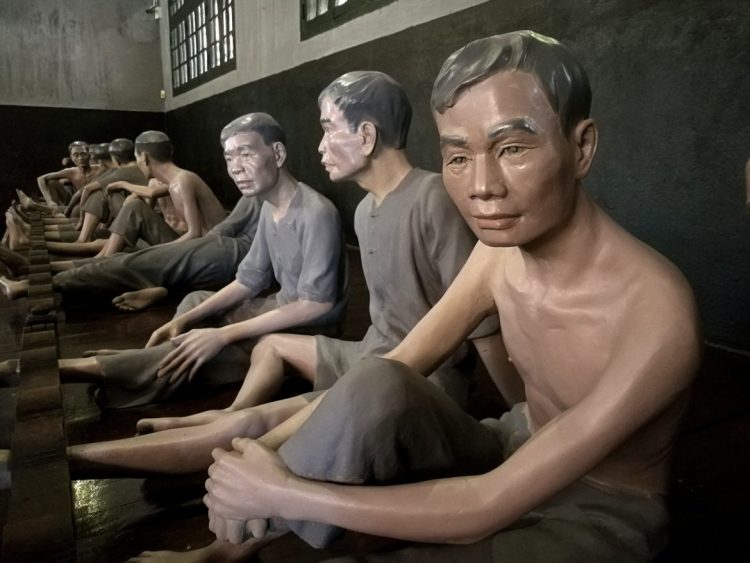
Source: Lux Travel DMC
2. History of Hoa Lo prison
The prison was constructed in 1896 by the French colonists as a central prison for both the Central and the Northern part of Vietnam. The purpose is to capture and torture those against the French colonial government such as Vietnamese patriots, revolutionaries, and political prisoners. Many famous Vietnamese revolutionary leaders and even five General Secretaries of the Communist Party were detained here namely Do Muoi, Le Duan, Nguyen Van Cu, etc.
Regardless of the brutal condition, the Vietnamese soldiers still keep their will and turn the chamber into school to popularize and propagandize revolutionary doctrines and activities.
At that time, Hoa Lo prison is called “Maison Centrale” ( which means Hanoi prison) or “Central House”.
After the liberation of Northern Vietnam in 1954, Hoa Lo prison was temporally managed by the government to imprison those who violate the law.
During the Dien Bien Phu in the air campaign, it was to capture hundreds of American pilots and prisons of war (POWs) included Douglas Peter Peterson who later known as the first US Ambassador in Vietnam and the US Senator John McCain. Those American prisoners ironically gave Hoa Lo prison the nickname “Hanoi Hilton” though everyone knows it is not like a hotel at all.

Source: Wikipedia
Hoa Lo prison was still active after 1973 then the government decided to relocate the detention area of the prison to the outskirts of Hanoi which now is the Detention center No.1 of Hanoi Police.
Nowadays, a part of the prison remains as a historical relic to memorize the heroic Vietnamese soldiers.
III. Construction and architecture of Hoa Lo prison
1. Construction and capacity of the chambers
During the French colonial period, the entire Hoa Lo prison is divided into 4 main zones: A, B, C, and D.
Respectively, zone A and B are for prisoners under investigation, less important prisoners or those who violate the prison disciplines.
Zone C is for French or foreign prisoners while zone D is for prisoners under the death penalty.
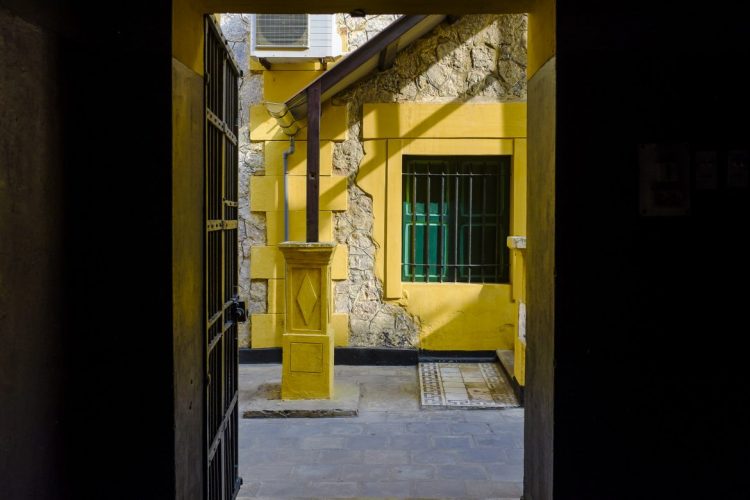
Source: Flickr – arcibald
Primarily, Hoa Lo prison was intended to hold 450 prisoners but the real number is much higher eventually with 615 and 2000 detainees in 1913 and 1953 respectively. It was about 25 to 30 prisoners who shared a small, dark and cramped chamber.
2. Architecture
In the past, the overall area of Hoa Lo prison was up to 12.000 m2 but now it is only about 2.500 m2 preserved.
The solidity of Hoa Lo prison is reflected in the architecture design, the walls, and the cells.
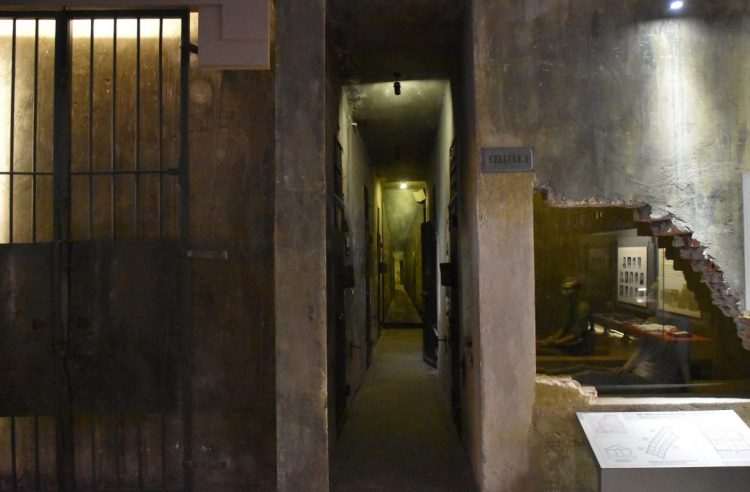
Source: Flickr – Richard Mortel
The biggest prison in Indochina and 1 of the three most brutal prisons in Vietnam, Hoa Lo prison is almost unbreakable with 4-meter-high and 0.5-meter-thick stone walls reinforced with electric wires and pieces of broken glass on top. The complex is constructed with high-quality materials to avoid jailbreak.
Although they are different in terms of area and functions, those chambers have identical features: tile roofs lacquered floors colored in gray. All of them are suffocating, lack of light and unsanitary.
The security is at its max when all of the building materials and equipment are directly imported from France. There are also watchtowers in each corner of the prison.
IV. Famous artifacts exhibiting in Hoa Lo prison
Being notorious by various brutal stories of torturing and killing people in a struggling period of Vietnam, the big collections of artifacts and killing tools exhibiting at Hoa Lo prison is the best representers of crimes against humanity.
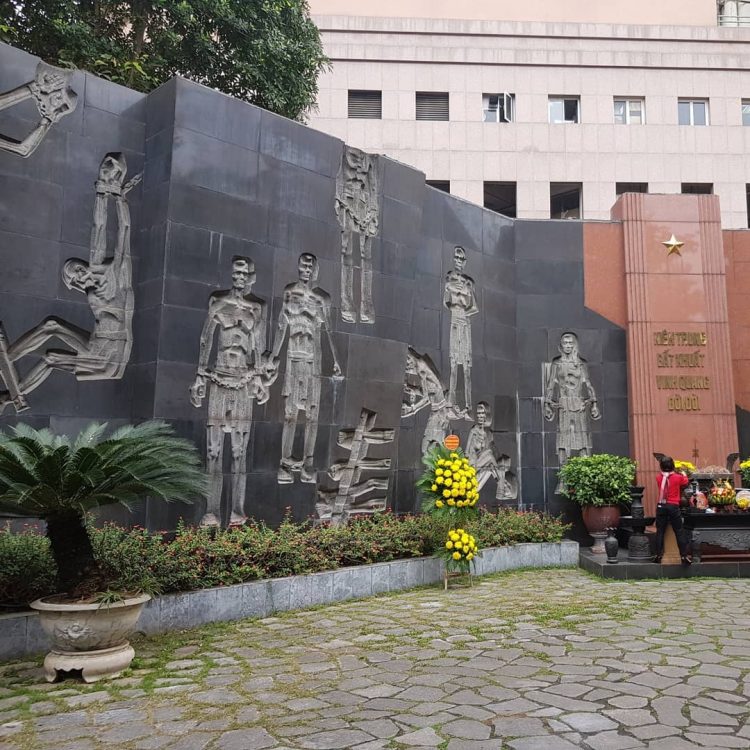
Source: Instagram @binomus
1. The guillotine
The most famous and cruel one is Medieval guillotine. There are 3 parts of the machine which are a wooden surface, a cutting steel frame and a big, and sharp blade. On execution, after the headman drags the rope connecting with the blade like a pulley, the blade drops down and the prisoner’s head is chopped down immediately. The guillotine made Hoa Lo prison 1 of the 10 most notorious prisons in the world.
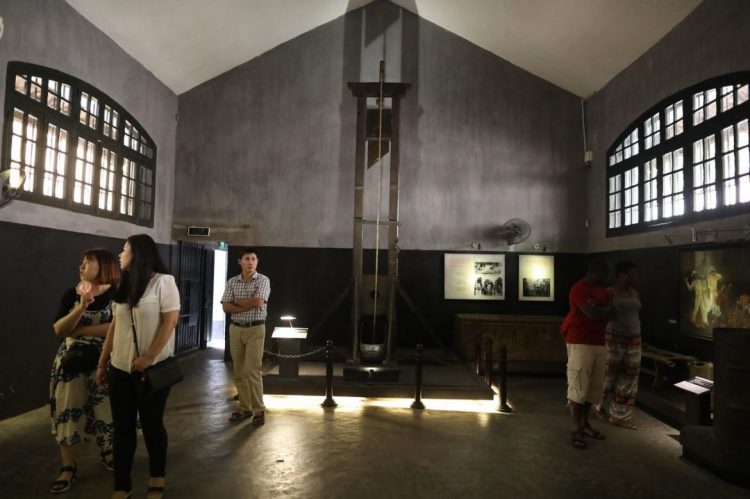
Source: Vnexpress – Ngọc Thành
2. The cachot
The scariest place of Hoa Lo prison – the cachot is applied for those who violate the prison disciplines. They were isolated and fettered all the time while eating, sleeping and urinating in the same place. Those detainees are given foods with mold and even maggots in there. Many of them died of infection, insanitation along with lack of light and oxygen.
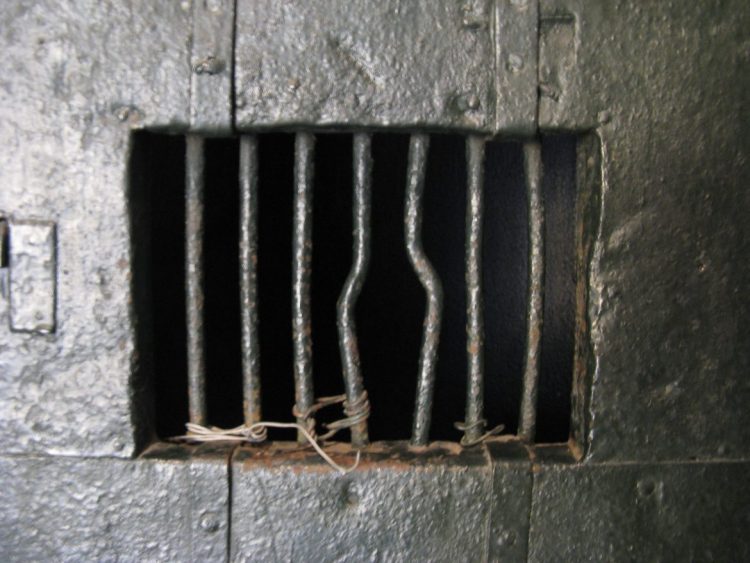
Source: Flickr – meestapeta
3. The iron shackle
The shackle is to keep the prisoners immovable. They are fettered to the floor most of the time and beaten by the guards.
The leg shackle consists of 2 main components: the iron upper part and the wooden lower one. To escape from the chamber, jailbreakers often used fat and burned coal to loosen the shackles.
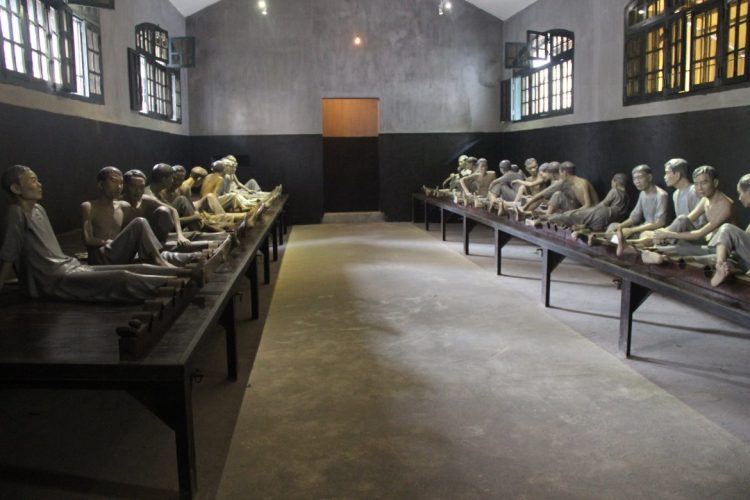
Source: Flickr – Gary Todd
Furthermore, because the prison is located in the center of Hanoi so from here you can explore more tourist-attractions nearby namely Temple of Literature, Hoan Kiem Lake, Old Quarter, and One-Pillar Pagoda.
Notes: The signs in Hoa Lo prison is written in Vietnamese and translated into English and French so you can easily guide yourself here. If not, you can book a private tour at Hoa Lo prison with Lux Travel DMC for in-depth information about the place.
EXPLORE FAMOUS LOCATIONS IN HANOI!
- EXPLORING HANOI NIGHTLIFE – 7 MUST-VISIT DESTINATIONS AT THE FRENCH QUARTER
- 08 BEST HANOI OLD QUARTER DISHES – TOP MUST-TRY FOODS IN HANOI
- HANOI OPERA HOUSE – A WITNESS OF TIME
V. About Lux Travel DMC
Founded in 2005, we have 15 years of experience in designing private tours with capable and wholehearted staff. We also have offices based in Vietnam, Thailand, Laos, Cambodia, and Myanmar which provide classy services. We are all-ears to your requirements, proved by 99% of satisfaction rate and good recommendation on TripAdvisor.
Our team is willing to give you an authentic holiday and the most proper type of food, accommodation, and activities.
Please contact us to customize your trip on the Lux Travel DMC website.
Let us be your guide!
Contact Us
- Address: No.456 Lac Long Quan Street, Tay Ho District, Hanoi, Vietnam
- Phone: (+84) 4 3927 4120
- Email: sales@luxtraveldmc.com
- Hotline: +84-336-276-996
- Website: https://luxtraveldmc.com
